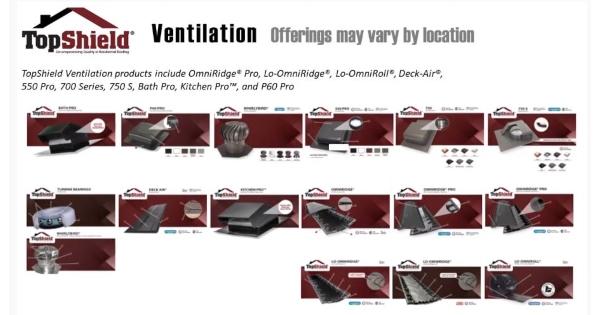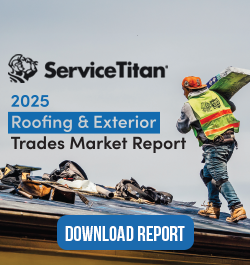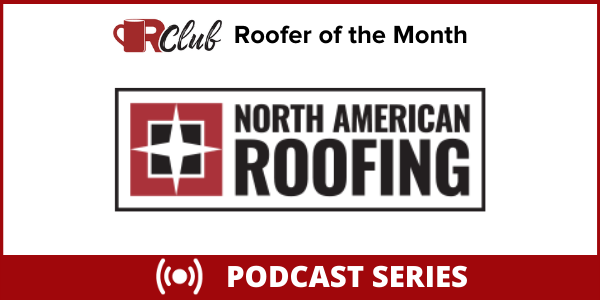Let’s Talk Ventilation

By Lauren White, RCS Assistant Editor.
Designed with contractors in mind, TopShield ventilation products are efficient and easy to use.
Ventilation is oftentimes not given as much attention as other components of a roofing system. However, ventilation is vital to keeping your customers' homes energy efficient and protecting the roof’s longevity by bringing fresh air into the attic and expelling excess heat and moisture.
While many homeowners might think color is the most important roofing choice, if they want a long-lasting roof, the ventilation system is more crucial to discuss than selecting a color. John DeRosa, the director of contractor training and customer experience at SRS Distribution shared, “It’s my very strong recommendation that salespeople use the product presentation stage to educate their customers on the way attic ventilation helps the roof meet its life expectancy.” This is especially true since moisture is one of the biggest threats a home can face. With appropriate ventilation, a roof and home can be protected from damage.
In a video by SRS Distribution, John explains, “As much as I understand the fear of over complicating the sales discussion, I do believe ventilation is a critically important topic that gives the salesperson the ability to further position themselves as the expert...” He continues to share the benefits of having this conversation, stating, “You can tell the client how ventilation helps to fight summertime heat buildup, winter time moisture buildup and ice dams in snow regions.”
Whether a home is located on the coast or in the desert, moisture will find a way into the attic, and can originate from both inside and outside the home. Bulk water from heavy rains and other extreme weather may not be let in during a storm, but if the water stays on the roof, it can penetrate the surface and get inside the home. Without a properly installed ventilation system, the moisture can destroy a roof. Moisture also comes from inside the home through activities like cooking, bathing and laundry. A family of four produces two to four gallons of water vapor everyday. Over one gallon of vapor is produced through breathing and perspiration! The water vapor rises with warm air into the attic, a cooler and drier location, and gets trapped. If it doesn’t escape from the attic it can develop into mold, mildew or wood rot, compromising the quality of the air inside the home.
When installing a ventilation system, contractors need to determine the correct amount of ventilation needed for the attic space, known as the Net Free Area (NFA). Both the International Building Code (IBC) and International Residential Code (IRC) require a minimum ventilation ratio of 1:150, which means the system needs one square foot of vent area for each 150 square feet of attic/roof area. However, if a vapor retarder is already installed, “The U.S. Federal Housing authority recommends a minimum of at least 1 square foot of attic ventilation...for every 300 square feet of attic floor space,” SRS Distribution shares.
A good ventilation system is a balanced and sealed system, and a balanced system has 50% intake ventilation and 50% exhaust ventilation. If there is an imbalance it can disrupt the airflow, drawing air from the home and into the attic, reducing energy efficiency. Additionally, an attic that is properly sealed and insulated will help prevent conditioned air from escaping into the attic, thus making the home more comfortable.
In order to successfully install a ventilation system, contractors need quality products, and that’s where SRS Distribution comes in. Their line of TopShield ventilation products includes intake and exhaust vents, ridge vents and even specialized bathroom and kitchen roof vents. TopShield has products that are low profile, can be installed with a hammer or nail gun, offer enhanced weather protection and some even have a Class A fire rating. With contractors in mind, these products are designed for efficiency.
“TopShield’s ventilation products have a solution for almost any application with the quality you’d expect,” John shares. OmniRidge® Pro is backed by a limited lifetime warranty and has unique “posi-tabs” that contour to the shingles, providing superior protection from the elements. According to John, “OmniRidge Pro features a low profile design, has internal baffles, external baffles and a sonic welded fiberglass providing enhanced weather protection.”
For contractors in search of a product that is easy to handle, look no further than Lo-OmniRoll®. This compact, 30-foot roll of ridge vent has a molded centerline for fast and easy alignment and even comes with two rolls of gunnable nails. The nail holes are marked every six inches and have supports every foot so the vent won’t be crushed down. The field-tested design of Lo-OmniRoll has been proven to be effective under all weather conditions.
See TopShield’s full line of ventilation products here, including Lo-OmniRidge®, Deck-Air®, 550 Pro, 700 Series, 750 S, Bath Pro, Kitchen Pro™ and P60 Pro.
Since ventilation is a core part of the roofing system and it often gets overlooked, when contractors discuss ventilation needs and options with homeowners, they are differentiating their company from the competition. Ron Bastian, the owner and president of Bastian Roofing Inc. in Wisconsin makes ventilation a key part of his sales discussion because, “...80 percent or better of my competition does not educate the homeowner about the importance of attic ventilation.” Similarly, the owner and president of Mid Towne Construction Inc., Corey Ballweg, shared, “I give attic ventilation the same emphasis as selecting the proper shingle for the project. I explain the potential decking, shingle, ice dam and energy issues that result from poor attic ventilation.”
Ventilation is a critically-important component of the roofing system that, when discussed, helps differentiate your company and ensures a roof’s long and healthy life. Proper ventilation will maximize the performance and durability of a roof, keep your customers’ home energy efficient and reduce greenhouse gas emissions. Don’t underestimate the power of discussing ventilation with your customers.
Learn more about SRS Distribution in their RoofersCoffeeShop® Directory.






















Comments
Leave a Reply
Have an account? Login to leave a comment!
Sign In